F.I.L.A. - Fabbrica Italiana Lapis ed Affini Bundle
How did F.I.L.A. transform from an Italian startup to a global creative powerhouse?
Dive into the compelling F.I.L.A. - Fabbrica Italiana Lapis ed Affini SWOT Analysis to understand the journey of F.I.L.A., a company that began in Florence, Italy, and blossomed into a global leader in art materials and stationery. From its inception in 1920, Fabbrica Italiana Lapis ed Affini, or F.I.L.A., has been synonymous with quality and innovation, providing artists and students with tools to fuel their creativity. Explore the FILA history and discover the remarkable evolution of this iconic brand.
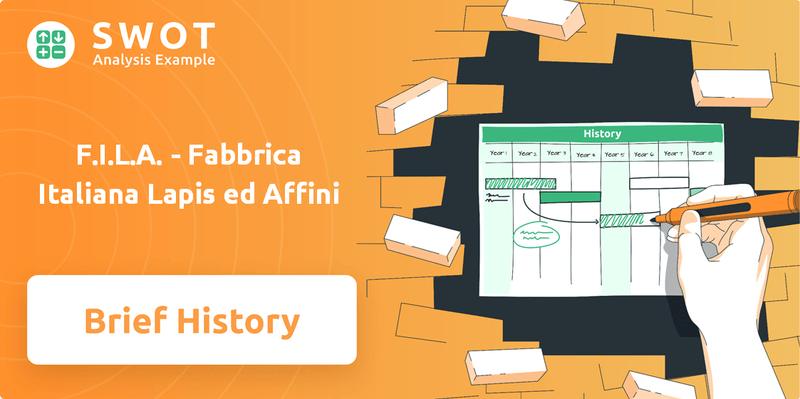
The story of F.I.L.A. is a testament to strategic foresight and adaptability. Initially focused on writing instruments, the company quickly expanded its offerings, establishing a strong presence in the Italian stationery market. This early success paved the way for acquisitions and brand diversification, transforming F.I.L.A. into a multinational corporation with a portfolio of globally recognized brands. Understanding the brief history of F.I.L.A. company provides valuable insights into its enduring success and its impact on the stationery industry.
What is the F.I.L.A. - Fabbrica Italiana Lapis ed Affini Founding Story?
The story of F.I.L.A., or Fabbrica Italiana Lapis ed Affini, began on April 13, 1920, in Florence, Italy. A group of Italian entrepreneurs saw an opportunity to create a company that would meet the growing need for quality writing and drawing instruments. Their vision was to establish a strong Italian enterprise focused on producing pencils and other stationery items.
The founders identified a clear need for domestically produced, high-quality art and school supplies. This addressed the potential reliance on imports at the time. The company's initial focus was on producing and selling pencils, emphasizing durability and performance. The name, Fabbrica Italiana Lapis ed Affini, which translates to 'Italian Pencil and Related Products Factory,' directly reflected its core business.
The economic environment of post-World War I Italy played a significant role. The push for industrialization and national self-sufficiency likely influenced the company's creation. This context helped F.I.L.A. succeed in meeting the domestic demand. The company's early success was rooted in this strategic alignment with the needs of the Italian market.
F.I.L.A. was founded in Florence, Italy, on April 13, 1920.
- The founders aimed to produce high-quality writing instruments.
- The initial business model focused on pencil production.
- The company's name directly reflects its core products.
- The founding occurred during a period of industrialization in Italy.
The early days of F.I.L.A., or Fabbrica Italiana Lapis ed Affini, were marked by a clear purpose: to provide Italy with top-quality writing tools. The company's commitment to Italian manufacturing and its straightforward approach to its product line were key elements of its early identity. For more insights into the company's values, you can read about the Mission, Vision & Core Values of F.I.L.A. - Fabbrica Italiana Lapis ed Affini.
F.I.L.A. - Fabbrica Italiana Lapis ed Affini SWOT Analysis
- Complete SWOT Breakdown
- Fully Customizable
- Editable in Excel & Word
- Professional Formatting
- Investor-Ready Format
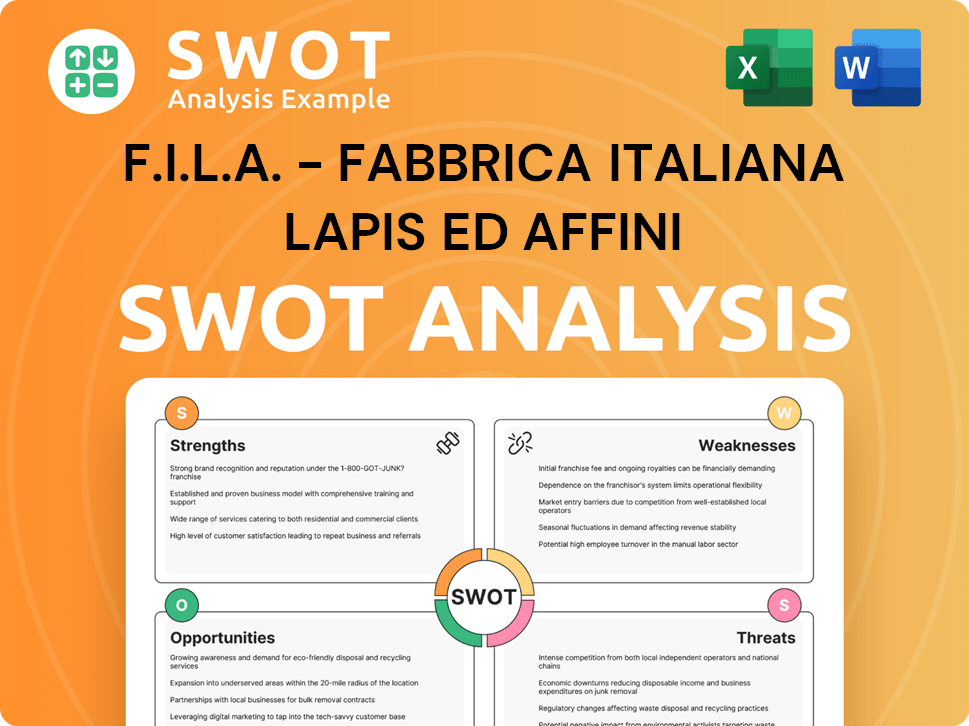
What Drove the Early Growth of F.I.L.A. - Fabbrica Italiana Lapis ed Affini?
The early growth of Fabbrica Italiana Lapis ed Affini (F.I.L.A.), a company with a rich FILA history, was marked by the expansion of its product range and its growing presence within Italy. F.I.L.A. diversified beyond pencils, introducing a wider array of art and school supplies. This strategic move helped establish its reputation for quality and reliability in the market of Italian stationery.
Following its founding in 1920, F.I.L.A. expanded its offerings beyond basic pencils. The company introduced colored pencils, pastels, and other drawing materials. This diversification was crucial in meeting the evolving needs of students and artists.
The 1950s were significant for F.I.L.A., especially with the 1952 launch of the Giotto brand. Giotto quickly became a household name for school art supplies in Italy. This strategic move significantly boosted F.I.L.A.'s market share in the educational sector.
Further innovation included the introduction of Giotto Cera crayons in 1965 and Giotto Turbo Color markers in 1973. These product launches solidified F.I.L.A.'s market position. These innovations helped expand its customer base beyond traditional artists to include children and hobbyists.
In the late 20th and early 21st centuries, F.I.L.A. expanded internationally through strategic acquisitions. The acquisition of Lyra in 2008, Daler-Rowney in 2016, and Maimeri in 2017 broadened its product portfolio and global reach. This strategy has positioned F.I.L.A. as a global leader in the art and stationery industry.
F.I.L.A. - Fabbrica Italiana Lapis ed Affini PESTLE Analysis
- Covers All 6 PESTLE Categories
- No Research Needed – Save Hours of Work
- Built by Experts, Trusted by Consultants
- Instant Download, Ready to Use
- 100% Editable, Fully Customizable
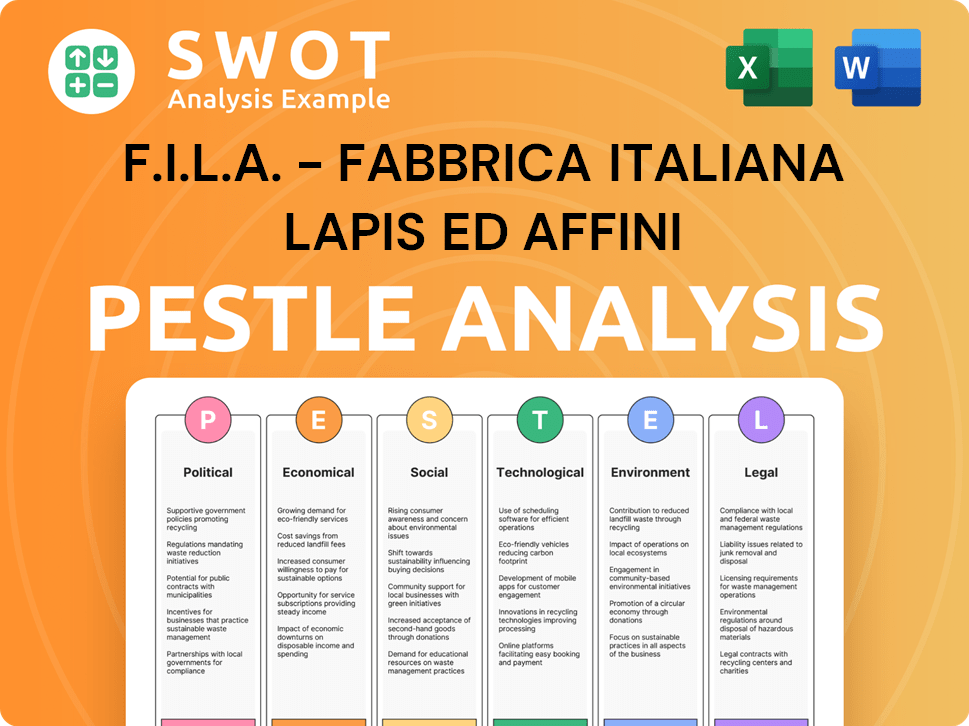
What are the key Milestones in F.I.L.A. - Fabbrica Italiana Lapis ed Affini history?
The F.I.L.A. (Fabbrica Italiana Lapis ed Affini) company's journey is marked by significant milestones, from its early days to its present status as a global leader in the writing instruments and art supplies sector. This FILA history is a testament to its adaptability and strategic vision.
| Year | Milestone |
|---|---|
| 1920 | F.I.L.A. was founded in Florence, Italy, marking the beginning of its journey in the stationery industry. |
| 1952 | The launch of the Giotto brand revolutionized the Italian school supplies market, introducing high-quality products. |
| 1965 | Giotto Cera crayons were introduced, expanding the brand's offerings in the educational sector. |
| 1973 | Giotto Turbo Color markers were launched, further solidifying the brand's presence. |
| 2008 | The acquisition of Lyra marked a strategic move towards international expansion. |
| 2016 | Daler-Rowney was acquired, broadening F.I.L.A.'s product portfolio and market reach. |
| 2017 | Maimeri was integrated, enhancing F.I.L.A.'s presence in the art supplies market. |
F.I.L.A. has consistently focused on innovation, particularly in product development and manufacturing. The company has secured patents for advancements in pencil manufacturing and material composition, leading to superior products.
The launch of the Giotto brand in 1952 was a major innovation, introducing high-quality and accessible products to the Italian school supplies market. This initiative helped establish F.I.L.A. as a key player in the educational sector.
The introduction of Giotto Cera crayons in 1965 expanded the product range, offering durable and vibrant crayons for children. This innovation further cemented the Giotto brand's reputation.
The launch of Giotto Turbo Color markers in 1973 provided a new, high-quality marker option for schools and artists. This product innovation helped solidify F.I.L.A.'s position in the market.
F.I.L.A. has secured patents for advancements in pencil manufacturing. These innovations have led to improved product quality and durability.
Innovation in material composition is another key area for F.I.L.A.. This has allowed the company to create products that are both high-performing and environmentally conscious.
F.I.L.A. has expanded into complementary areas like creative kits. This move was a strategic response to the shift towards digital tools.
F.I.L.A. has faced various challenges, including market fluctuations and competitive pressures. The company's ability to adapt and innovate has been crucial for maintaining its market position. For a deeper dive into how F.I.L.A. navigates the competitive landscape, explore the Competitors Landscape of F.I.L.A. - Fabbrica Italiana Lapis ed Affini.
F.I.L.A. has navigated several market downturns by adjusting its product offerings and marketing strategies. This flexibility has been key to maintaining profitability.
The company has addressed competitive threats by focusing on the tactile and creative benefits of its products. This approach has helped differentiate F.I.L.A. in the market.
Fluctuations in raw material prices have presented challenges, especially in recent years. Strategic restructuring has been a key response to these fluctuations.
Global supply chain disruptions have tested the company's resilience. F.I.L.A. has responded with strategic adjustments to mitigate these challenges.
Integrating acquired brands like Lyra, Daler-Rowney, and Maimeri has presented challenges related to brand integration. Maintaining consistent quality across a broader range of products is also a key focus.
Despite these challenges, F.I.L.A. has demonstrated resilience, reporting a net profit of €33.8 million in 2023. This reflects its ability to adapt and thrive in a dynamic market.
F.I.L.A. - Fabbrica Italiana Lapis ed Affini Business Model Canvas
- Complete 9-Block Business Model Canvas
- Effortlessly Communicate Your Business Strategy
- Investor-Ready BMC Format
- 100% Editable and Customizable
- Clear and Structured Layout
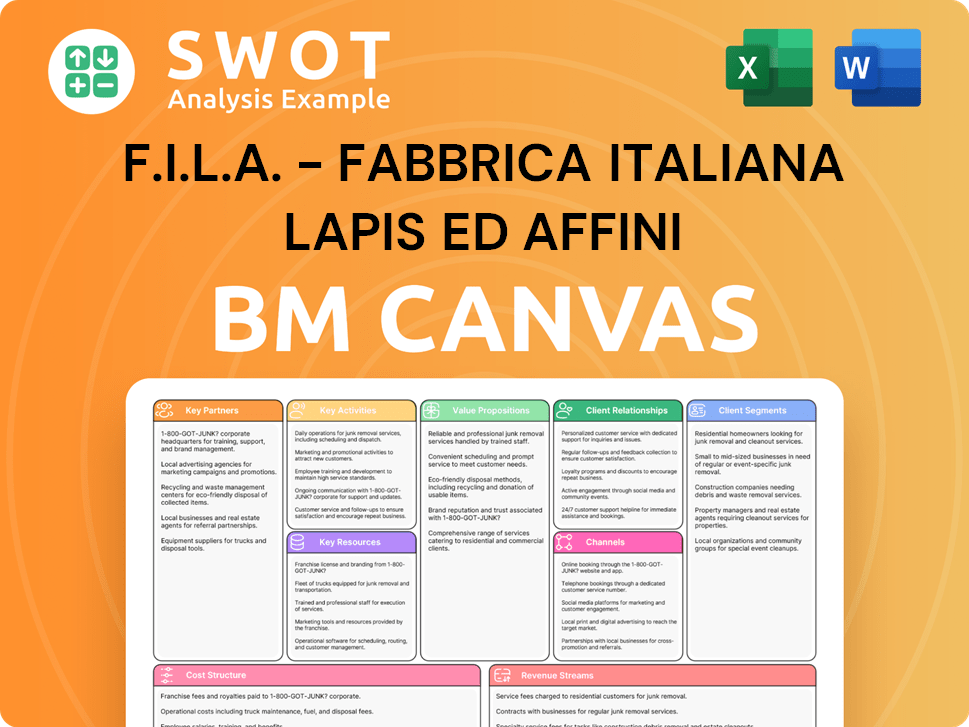
What is the Timeline of Key Events for F.I.L.A. - Fabbrica Italiana Lapis ed Affini?
The journey of F.I.L.A. - Fabbrica Italiana Lapis ed Affini, a prominent name in the writing instruments and Italian stationery sector, is marked by strategic expansions and product innovations. Founded in Florence, Italy, the company has grown from its roots to become a global player, significantly impacting the stationery industry. The evolution of F.I.L.A. showcases its adaptability and commitment to providing quality products for creativity. This brief history of F.I.L.A. company demonstrates its resilience and vision in a dynamic market.
| Year | Key Event |
|---|---|
| 1920 | F.I.L.A. - Fabbrica Italiana Lapis ed Affini is established in Florence, Italy, marking the beginning of its journey. |
| 1952 | The launch of the Giotto brand, which quickly became a staple in Italian schools. |
| 1965 | Introduction of Giotto Cera crayons, expanding the Giotto product line. |
| 1973 | The release of Giotto Turbo Color markers, another innovative product. |
| 2008 | Acquisition of Lyra, a German manufacturer, expanding its international presence. |
| 2016 | Acquisition of Daler-Rowney Lukas, enhancing its presence in the professional art market. |
| 2017 | Acquisition of Maimeri, further solidifying its position in the professional art segment. |
| 2019 | Acquisition of Pacon Group, expanding its presence in the US market. |
| 2023 | F.I.L.A. reports consolidated revenue of €763 million and a net profit of €33.8 million. |
F.I.L.A. aims to fortify its global leadership. This involves continued investment in research and development, ensuring the introduction of innovative products. The company is also focused on expanding its digital presence and e-commerce capabilities. The strategic acquisitions, such as the Pacon Group, have significantly broadened its market reach.
Sustainability is a key focus for F.I.L.A., with efforts to reduce its environmental footprint. They are committed to sustainable practices and responsible sourcing. The company continues to innovate, adapting to the growing interest in creative hobbies and the importance of sustainable products. The Target Market of F.I.L.A. - Fabbrica Italiana Lapis ed Affini article provides further insights.
F.I.L.A. is exploring new market opportunities, particularly in emerging economies. The company leverages its strong brand portfolio and global distribution network to drive future growth. This forward-looking approach aligns with the founding vision of providing high-quality tools for creativity. F.I.L.A. is well-positioned to capitalize on the ongoing digitalization of commerce.
In 2023, F.I.L.A. reported a consolidated revenue of €763 million, demonstrating its financial strength. The net profit for the same year was €33.8 million. These figures reflect the company's successful global market penetration and strategic growth initiatives. The company's consistent performance underscores its strong position in the writing instruments market.
F.I.L.A. - Fabbrica Italiana Lapis ed Affini Porter's Five Forces Analysis
- Covers All 5 Competitive Forces in Detail
- Structured for Consultants, Students, and Founders
- 100% Editable in Microsoft Word & Excel
- Instant Digital Download – Use Immediately
- Compatible with Mac & PC – Fully Unlocked
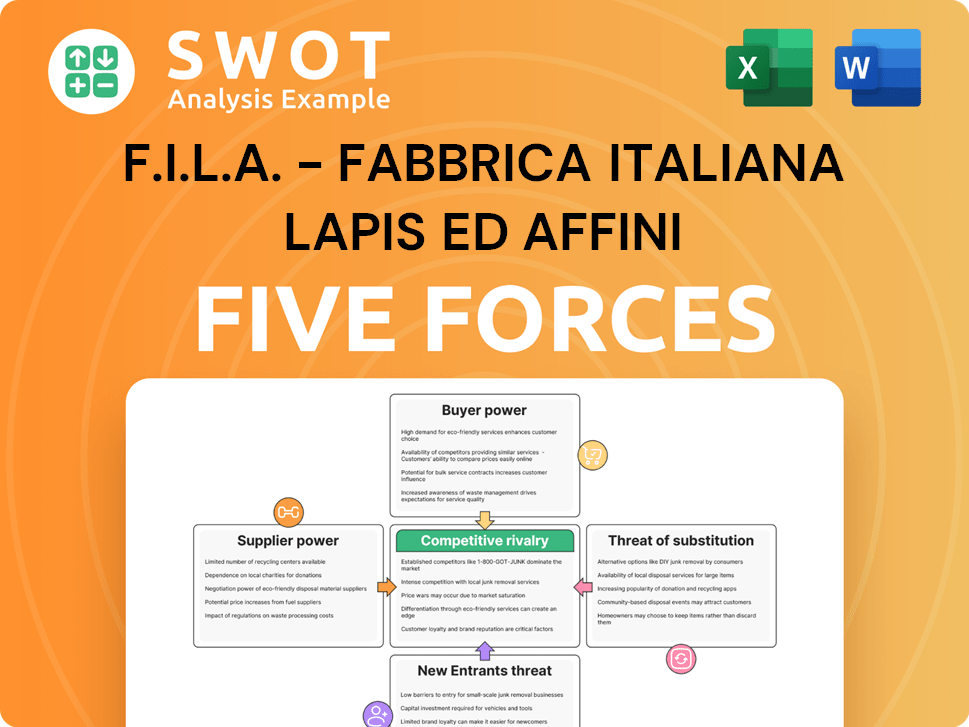
Related Blogs
- What is Competitive Landscape of F.I.L.A. - Fabbrica Italiana Lapis ed Affini Company?
- What is Growth Strategy and Future Prospects of F.I.L.A. - Fabbrica Italiana Lapis ed Affini Company?
- How Does F.I.L.A. - Fabbrica Italiana Lapis ed Affini Company Work?
- What is Sales and Marketing Strategy of F.I.L.A. - Fabbrica Italiana Lapis ed Affini Company?
- What is Brief History of F.I.L.A. - Fabbrica Italiana Lapis ed Affini Company?
- Who Owns F.I.L.A. - Fabbrica Italiana Lapis ed Affini Company?
- What is Customer Demographics and Target Market of F.I.L.A. - Fabbrica Italiana Lapis ed Affini Company?
Disclaimer
All information, articles, and product details provided on this website are for general informational and educational purposes only. We do not claim any ownership over, nor do we intend to infringe upon, any trademarks, copyrights, logos, brand names, or other intellectual property mentioned or depicted on this site. Such intellectual property remains the property of its respective owners, and any references here are made solely for identification or informational purposes, without implying any affiliation, endorsement, or partnership.
We make no representations or warranties, express or implied, regarding the accuracy, completeness, or suitability of any content or products presented. Nothing on this website should be construed as legal, tax, investment, financial, medical, or other professional advice. In addition, no part of this site—including articles or product references—constitutes a solicitation, recommendation, endorsement, advertisement, or offer to buy or sell any securities, franchises, or other financial instruments, particularly in jurisdictions where such activity would be unlawful.
All content is of a general nature and may not address the specific circumstances of any individual or entity. It is not a substitute for professional advice or services. Any actions you take based on the information provided here are strictly at your own risk. You accept full responsibility for any decisions or outcomes arising from your use of this website and agree to release us from any liability in connection with your use of, or reliance upon, the content or products found herein.